Delivery Units: Literature Review, Trends, and CM Dashboard Analysis
VerifiedAdded on 2021/04/24
|16
|7076
|510
Report
AI Summary
This report provides a comprehensive analysis of government delivery units, beginning with a literature review that examines their role in addressing social and economic challenges. It explores the functions of delivery units, including tracking policy outcomes, addressing implementation gaps, and designing policy implementation plans. The report delves into global trends, highlighting the increasing prevalence of delivery units at various governmental levels and the evolution to 'Delivery 2.0' frameworks. Key success components, such as reliable data, skilled personnel, and effective tools, are discussed, along with the importance of performance metrics and connection to decision-makers. The CM dashboard is analyzed as a tool for consolidating delivery unit information, providing insights into various government programs and services through data visualization. The report covers project contracts, procurement methods, project scope, methodology, implementation, and design specifications. Project analysis and references conclude the report, providing a complete overview of delivery units' operations and effectiveness.
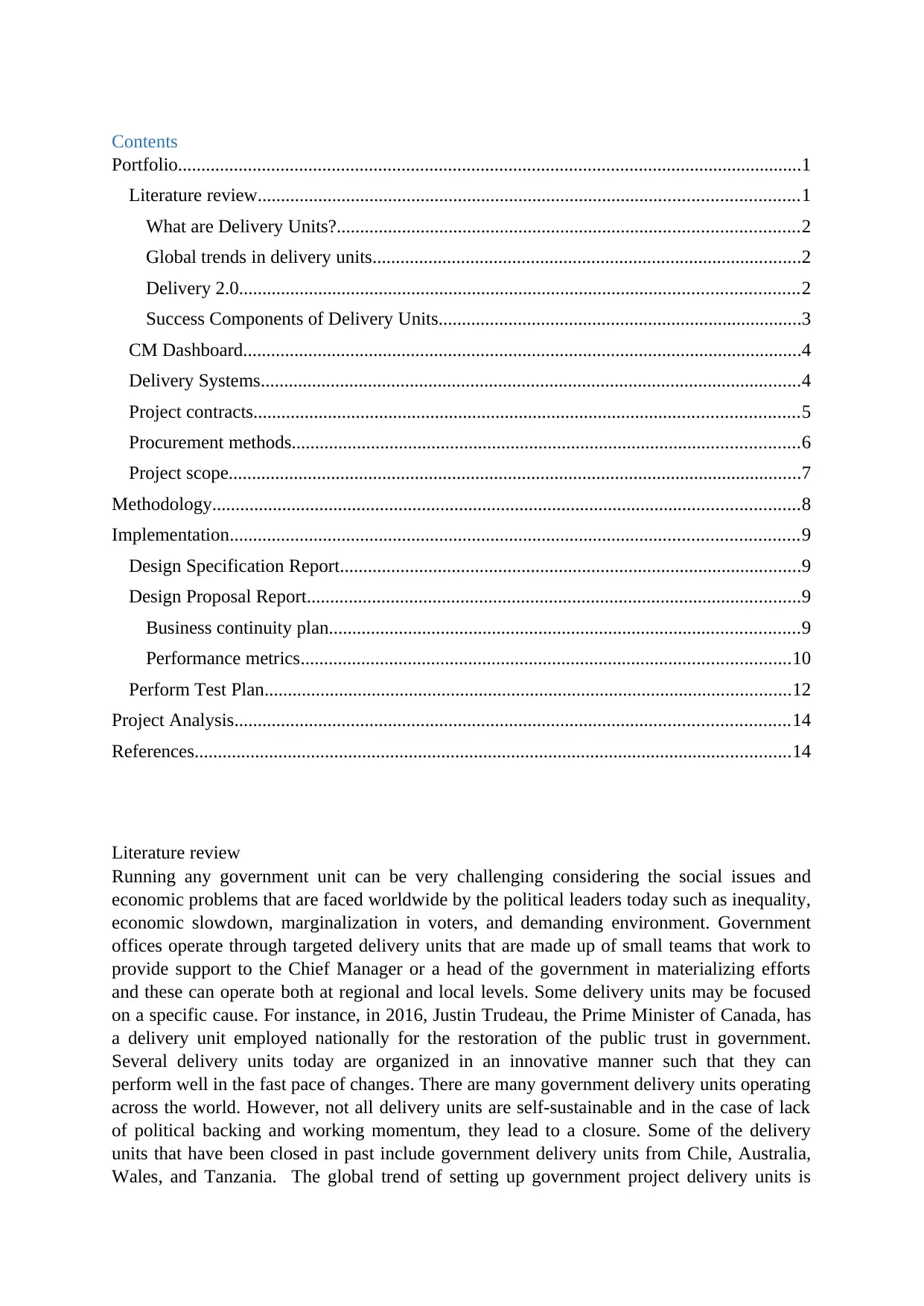
Contents
Portfolio......................................................................................................................................1
Literature review....................................................................................................................1
What are Delivery Units?...................................................................................................2
Global trends in delivery units............................................................................................2
Delivery 2.0........................................................................................................................2
Success Components of Delivery Units..............................................................................3
CM Dashboard........................................................................................................................4
Delivery Systems....................................................................................................................4
Project contracts.....................................................................................................................5
Procurement methods.............................................................................................................6
Project scope...........................................................................................................................7
Methodology..............................................................................................................................8
Implementation..........................................................................................................................9
Design Specification Report...................................................................................................9
Design Proposal Report..........................................................................................................9
Business continuity plan.....................................................................................................9
Performance metrics.........................................................................................................10
Perform Test Plan.................................................................................................................12
Project Analysis.......................................................................................................................14
References................................................................................................................................14
Literature review
Running any government unit can be very challenging considering the social issues and
economic problems that are faced worldwide by the political leaders today such as inequality,
economic slowdown, marginalization in voters, and demanding environment. Government
offices operate through targeted delivery units that are made up of small teams that work to
provide support to the Chief Manager or a head of the government in materializing efforts
and these can operate both at regional and local levels. Some delivery units may be focused
on a specific cause. For instance, in 2016, Justin Trudeau, the Prime Minister of Canada, has
a delivery unit employed nationally for the restoration of the public trust in government.
Several delivery units today are organized in an innovative manner such that they can
perform well in the fast pace of changes. There are many government delivery units operating
across the world. However, not all delivery units are self-sustainable and in the case of lack
of political backing and working momentum, they lead to a closure. Some of the delivery
units that have been closed in past include government delivery units from Chile, Australia,
Wales, and Tanzania. The global trend of setting up government project delivery units is
Portfolio......................................................................................................................................1
Literature review....................................................................................................................1
What are Delivery Units?...................................................................................................2
Global trends in delivery units............................................................................................2
Delivery 2.0........................................................................................................................2
Success Components of Delivery Units..............................................................................3
CM Dashboard........................................................................................................................4
Delivery Systems....................................................................................................................4
Project contracts.....................................................................................................................5
Procurement methods.............................................................................................................6
Project scope...........................................................................................................................7
Methodology..............................................................................................................................8
Implementation..........................................................................................................................9
Design Specification Report...................................................................................................9
Design Proposal Report..........................................................................................................9
Business continuity plan.....................................................................................................9
Performance metrics.........................................................................................................10
Perform Test Plan.................................................................................................................12
Project Analysis.......................................................................................................................14
References................................................................................................................................14
Literature review
Running any government unit can be very challenging considering the social issues and
economic problems that are faced worldwide by the political leaders today such as inequality,
economic slowdown, marginalization in voters, and demanding environment. Government
offices operate through targeted delivery units that are made up of small teams that work to
provide support to the Chief Manager or a head of the government in materializing efforts
and these can operate both at regional and local levels. Some delivery units may be focused
on a specific cause. For instance, in 2016, Justin Trudeau, the Prime Minister of Canada, has
a delivery unit employed nationally for the restoration of the public trust in government.
Several delivery units today are organized in an innovative manner such that they can
perform well in the fast pace of changes. There are many government delivery units operating
across the world. However, not all delivery units are self-sustainable and in the case of lack
of political backing and working momentum, they lead to a closure. Some of the delivery
units that have been closed in past include government delivery units from Chile, Australia,
Wales, and Tanzania. The global trend of setting up government project delivery units is
Paraphrase This Document
Need a fresh take? Get an instant paraphrase of this document with our AI Paraphraser
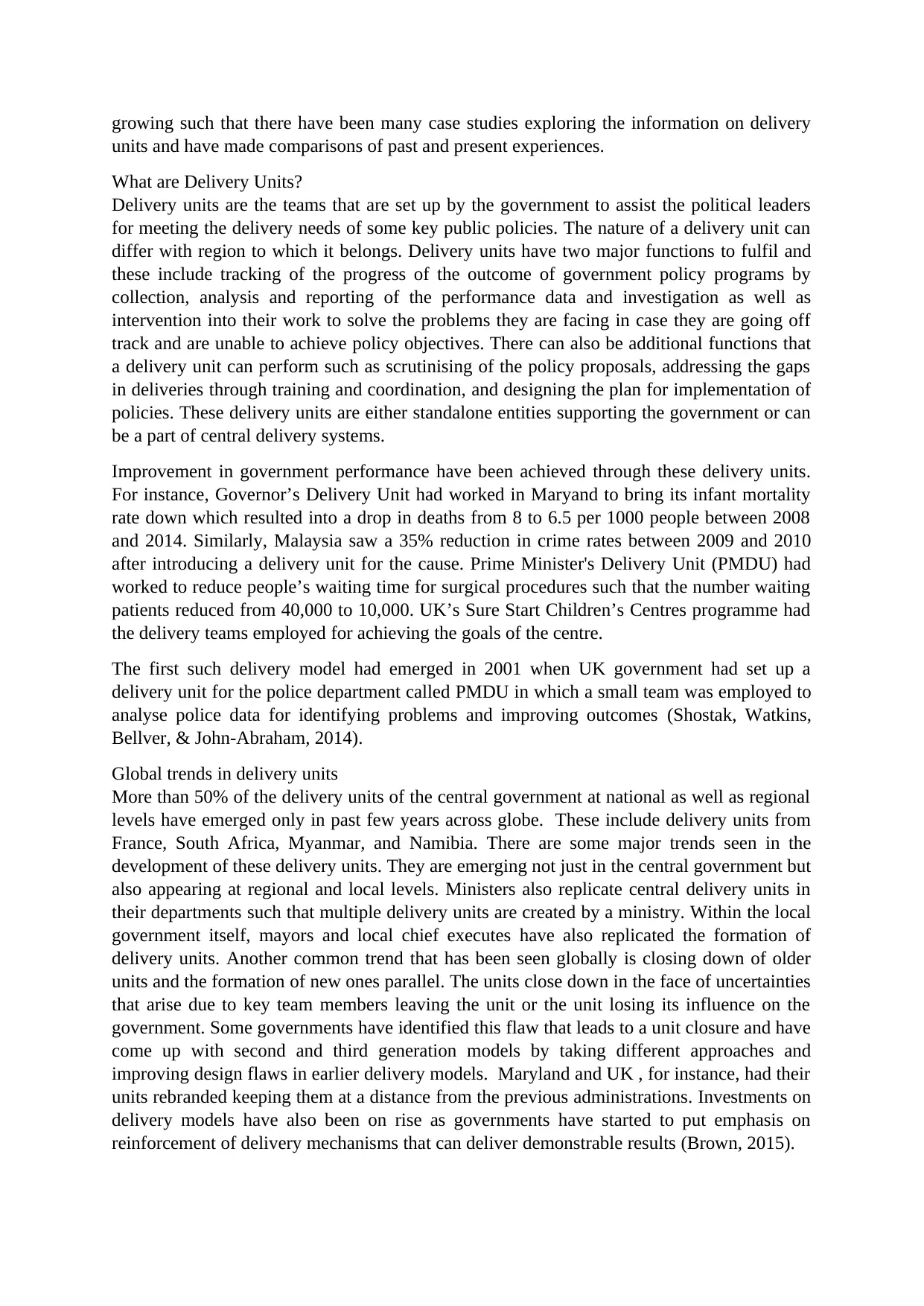
growing such that there have been many case studies exploring the information on delivery
units and have made comparisons of past and present experiences.
What are Delivery Units?
Delivery units are the teams that are set up by the government to assist the political leaders
for meeting the delivery needs of some key public policies. The nature of a delivery unit can
differ with region to which it belongs. Delivery units have two major functions to fulfil and
these include tracking of the progress of the outcome of government policy programs by
collection, analysis and reporting of the performance data and investigation as well as
intervention into their work to solve the problems they are facing in case they are going off
track and are unable to achieve policy objectives. There can also be additional functions that
a delivery unit can perform such as scrutinising of the policy proposals, addressing the gaps
in deliveries through training and coordination, and designing the plan for implementation of
policies. These delivery units are either standalone entities supporting the government or can
be a part of central delivery systems.
Improvement in government performance have been achieved through these delivery units.
For instance, Governor’s Delivery Unit had worked in Maryand to bring its infant mortality
rate down which resulted into a drop in deaths from 8 to 6.5 per 1000 people between 2008
and 2014. Similarly, Malaysia saw a 35% reduction in crime rates between 2009 and 2010
after introducing a delivery unit for the cause. Prime Minister's Delivery Unit (PMDU) had
worked to reduce people’s waiting time for surgical procedures such that the number waiting
patients reduced from 40,000 to 10,000. UK’s Sure Start Children’s Centres programme had
the delivery teams employed for achieving the goals of the centre.
The first such delivery model had emerged in 2001 when UK government had set up a
delivery unit for the police department called PMDU in which a small team was employed to
analyse police data for identifying problems and improving outcomes (Shostak, Watkins,
Bellver, & John-Abraham, 2014).
Global trends in delivery units
More than 50% of the delivery units of the central government at national as well as regional
levels have emerged only in past few years across globe. These include delivery units from
France, South Africa, Myanmar, and Namibia. There are some major trends seen in the
development of these delivery units. They are emerging not just in the central government but
also appearing at regional and local levels. Ministers also replicate central delivery units in
their departments such that multiple delivery units are created by a ministry. Within the local
government itself, mayors and local chief executes have also replicated the formation of
delivery units. Another common trend that has been seen globally is closing down of older
units and the formation of new ones parallel. The units close down in the face of uncertainties
that arise due to key team members leaving the unit or the unit losing its influence on the
government. Some governments have identified this flaw that leads to a unit closure and have
come up with second and third generation models by taking different approaches and
improving design flaws in earlier delivery models. Maryland and UK , for instance, had their
units rebranded keeping them at a distance from the previous administrations. Investments on
delivery models have also been on rise as governments have started to put emphasis on
reinforcement of delivery mechanisms that can deliver demonstrable results (Brown, 2015).
units and have made comparisons of past and present experiences.
What are Delivery Units?
Delivery units are the teams that are set up by the government to assist the political leaders
for meeting the delivery needs of some key public policies. The nature of a delivery unit can
differ with region to which it belongs. Delivery units have two major functions to fulfil and
these include tracking of the progress of the outcome of government policy programs by
collection, analysis and reporting of the performance data and investigation as well as
intervention into their work to solve the problems they are facing in case they are going off
track and are unable to achieve policy objectives. There can also be additional functions that
a delivery unit can perform such as scrutinising of the policy proposals, addressing the gaps
in deliveries through training and coordination, and designing the plan for implementation of
policies. These delivery units are either standalone entities supporting the government or can
be a part of central delivery systems.
Improvement in government performance have been achieved through these delivery units.
For instance, Governor’s Delivery Unit had worked in Maryand to bring its infant mortality
rate down which resulted into a drop in deaths from 8 to 6.5 per 1000 people between 2008
and 2014. Similarly, Malaysia saw a 35% reduction in crime rates between 2009 and 2010
after introducing a delivery unit for the cause. Prime Minister's Delivery Unit (PMDU) had
worked to reduce people’s waiting time for surgical procedures such that the number waiting
patients reduced from 40,000 to 10,000. UK’s Sure Start Children’s Centres programme had
the delivery teams employed for achieving the goals of the centre.
The first such delivery model had emerged in 2001 when UK government had set up a
delivery unit for the police department called PMDU in which a small team was employed to
analyse police data for identifying problems and improving outcomes (Shostak, Watkins,
Bellver, & John-Abraham, 2014).
Global trends in delivery units
More than 50% of the delivery units of the central government at national as well as regional
levels have emerged only in past few years across globe. These include delivery units from
France, South Africa, Myanmar, and Namibia. There are some major trends seen in the
development of these delivery units. They are emerging not just in the central government but
also appearing at regional and local levels. Ministers also replicate central delivery units in
their departments such that multiple delivery units are created by a ministry. Within the local
government itself, mayors and local chief executes have also replicated the formation of
delivery units. Another common trend that has been seen globally is closing down of older
units and the formation of new ones parallel. The units close down in the face of uncertainties
that arise due to key team members leaving the unit or the unit losing its influence on the
government. Some governments have identified this flaw that leads to a unit closure and have
come up with second and third generation models by taking different approaches and
improving design flaws in earlier delivery models. Maryland and UK , for instance, had their
units rebranded keeping them at a distance from the previous administrations. Investments on
delivery models have also been on rise as governments have started to put emphasis on
reinforcement of delivery mechanisms that can deliver demonstrable results (Brown, 2015).
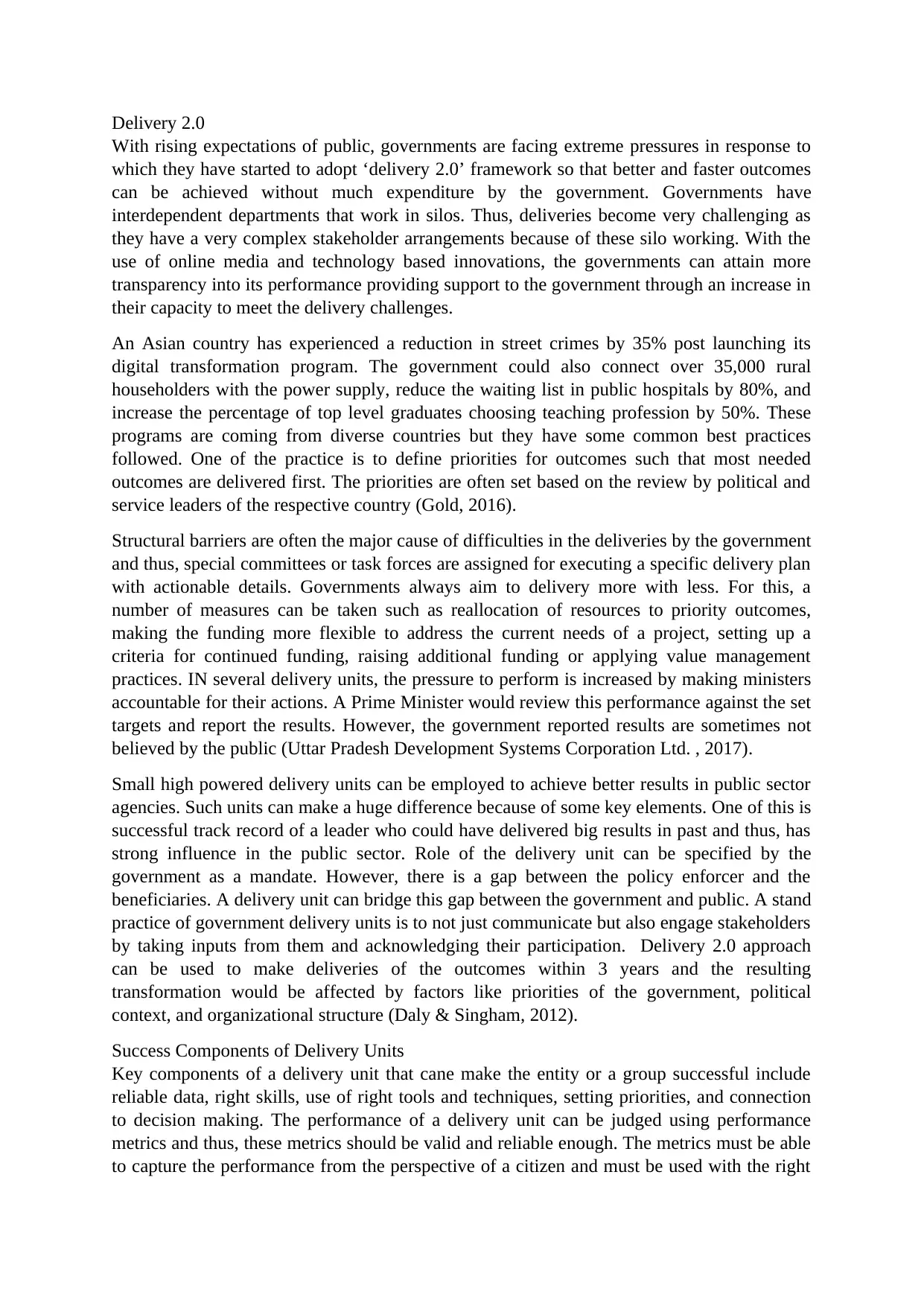
Delivery 2.0
With rising expectations of public, governments are facing extreme pressures in response to
which they have started to adopt ‘delivery 2.0’ framework so that better and faster outcomes
can be achieved without much expenditure by the government. Governments have
interdependent departments that work in silos. Thus, deliveries become very challenging as
they have a very complex stakeholder arrangements because of these silo working. With the
use of online media and technology based innovations, the governments can attain more
transparency into its performance providing support to the government through an increase in
their capacity to meet the delivery challenges.
An Asian country has experienced a reduction in street crimes by 35% post launching its
digital transformation program. The government could also connect over 35,000 rural
householders with the power supply, reduce the waiting list in public hospitals by 80%, and
increase the percentage of top level graduates choosing teaching profession by 50%. These
programs are coming from diverse countries but they have some common best practices
followed. One of the practice is to define priorities for outcomes such that most needed
outcomes are delivered first. The priorities are often set based on the review by political and
service leaders of the respective country (Gold, 2016).
Structural barriers are often the major cause of difficulties in the deliveries by the government
and thus, special committees or task forces are assigned for executing a specific delivery plan
with actionable details. Governments always aim to delivery more with less. For this, a
number of measures can be taken such as reallocation of resources to priority outcomes,
making the funding more flexible to address the current needs of a project, setting up a
criteria for continued funding, raising additional funding or applying value management
practices. IN several delivery units, the pressure to perform is increased by making ministers
accountable for their actions. A Prime Minister would review this performance against the set
targets and report the results. However, the government reported results are sometimes not
believed by the public (Uttar Pradesh Development Systems Corporation Ltd. , 2017).
Small high powered delivery units can be employed to achieve better results in public sector
agencies. Such units can make a huge difference because of some key elements. One of this is
successful track record of a leader who could have delivered big results in past and thus, has
strong influence in the public sector. Role of the delivery unit can be specified by the
government as a mandate. However, there is a gap between the policy enforcer and the
beneficiaries. A delivery unit can bridge this gap between the government and public. A stand
practice of government delivery units is to not just communicate but also engage stakeholders
by taking inputs from them and acknowledging their participation. Delivery 2.0 approach
can be used to make deliveries of the outcomes within 3 years and the resulting
transformation would be affected by factors like priorities of the government, political
context, and organizational structure (Daly & Singham, 2012).
Success Components of Delivery Units
Key components of a delivery unit that cane make the entity or a group successful include
reliable data, right skills, use of right tools and techniques, setting priorities, and connection
to decision making. The performance of a delivery unit can be judged using performance
metrics and thus, these metrics should be valid and reliable enough. The metrics must be able
to capture the performance from the perspective of a citizen and must be used with the right
With rising expectations of public, governments are facing extreme pressures in response to
which they have started to adopt ‘delivery 2.0’ framework so that better and faster outcomes
can be achieved without much expenditure by the government. Governments have
interdependent departments that work in silos. Thus, deliveries become very challenging as
they have a very complex stakeholder arrangements because of these silo working. With the
use of online media and technology based innovations, the governments can attain more
transparency into its performance providing support to the government through an increase in
their capacity to meet the delivery challenges.
An Asian country has experienced a reduction in street crimes by 35% post launching its
digital transformation program. The government could also connect over 35,000 rural
householders with the power supply, reduce the waiting list in public hospitals by 80%, and
increase the percentage of top level graduates choosing teaching profession by 50%. These
programs are coming from diverse countries but they have some common best practices
followed. One of the practice is to define priorities for outcomes such that most needed
outcomes are delivered first. The priorities are often set based on the review by political and
service leaders of the respective country (Gold, 2016).
Structural barriers are often the major cause of difficulties in the deliveries by the government
and thus, special committees or task forces are assigned for executing a specific delivery plan
with actionable details. Governments always aim to delivery more with less. For this, a
number of measures can be taken such as reallocation of resources to priority outcomes,
making the funding more flexible to address the current needs of a project, setting up a
criteria for continued funding, raising additional funding or applying value management
practices. IN several delivery units, the pressure to perform is increased by making ministers
accountable for their actions. A Prime Minister would review this performance against the set
targets and report the results. However, the government reported results are sometimes not
believed by the public (Uttar Pradesh Development Systems Corporation Ltd. , 2017).
Small high powered delivery units can be employed to achieve better results in public sector
agencies. Such units can make a huge difference because of some key elements. One of this is
successful track record of a leader who could have delivered big results in past and thus, has
strong influence in the public sector. Role of the delivery unit can be specified by the
government as a mandate. However, there is a gap between the policy enforcer and the
beneficiaries. A delivery unit can bridge this gap between the government and public. A stand
practice of government delivery units is to not just communicate but also engage stakeholders
by taking inputs from them and acknowledging their participation. Delivery 2.0 approach
can be used to make deliveries of the outcomes within 3 years and the resulting
transformation would be affected by factors like priorities of the government, political
context, and organizational structure (Daly & Singham, 2012).
Success Components of Delivery Units
Key components of a delivery unit that cane make the entity or a group successful include
reliable data, right skills, use of right tools and techniques, setting priorities, and connection
to decision making. The performance of a delivery unit can be judged using performance
metrics and thus, these metrics should be valid and reliable enough. The metrics must be able
to capture the performance from the perspective of a citizen and must be used with the right
⊘ This is a preview!⊘
Do you want full access?
Subscribe today to unlock all pages.

Trusted by 1+ million students worldwide
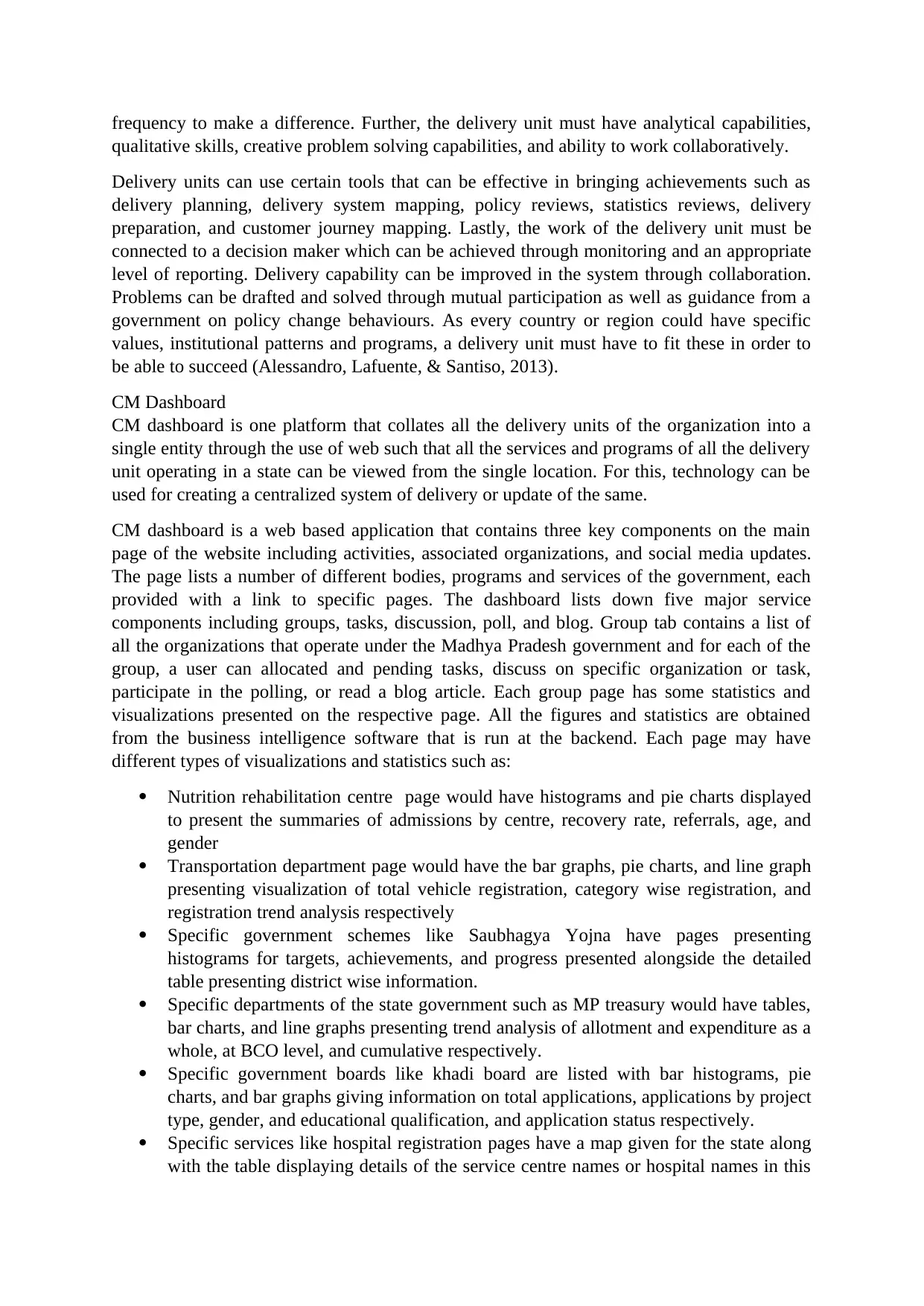
frequency to make a difference. Further, the delivery unit must have analytical capabilities,
qualitative skills, creative problem solving capabilities, and ability to work collaboratively.
Delivery units can use certain tools that can be effective in bringing achievements such as
delivery planning, delivery system mapping, policy reviews, statistics reviews, delivery
preparation, and customer journey mapping. Lastly, the work of the delivery unit must be
connected to a decision maker which can be achieved through monitoring and an appropriate
level of reporting. Delivery capability can be improved in the system through collaboration.
Problems can be drafted and solved through mutual participation as well as guidance from a
government on policy change behaviours. As every country or region could have specific
values, institutional patterns and programs, a delivery unit must have to fit these in order to
be able to succeed (Alessandro, Lafuente, & Santiso, 2013).
CM Dashboard
CM dashboard is one platform that collates all the delivery units of the organization into a
single entity through the use of web such that all the services and programs of all the delivery
unit operating in a state can be viewed from the single location. For this, technology can be
used for creating a centralized system of delivery or update of the same.
CM dashboard is a web based application that contains three key components on the main
page of the website including activities, associated organizations, and social media updates.
The page lists a number of different bodies, programs and services of the government, each
provided with a link to specific pages. The dashboard lists down five major service
components including groups, tasks, discussion, poll, and blog. Group tab contains a list of
all the organizations that operate under the Madhya Pradesh government and for each of the
group, a user can allocated and pending tasks, discuss on specific organization or task,
participate in the polling, or read a blog article. Each group page has some statistics and
visualizations presented on the respective page. All the figures and statistics are obtained
from the business intelligence software that is run at the backend. Each page may have
different types of visualizations and statistics such as:
Nutrition rehabilitation centre page would have histograms and pie charts displayed
to present the summaries of admissions by centre, recovery rate, referrals, age, and
gender
Transportation department page would have the bar graphs, pie charts, and line graph
presenting visualization of total vehicle registration, category wise registration, and
registration trend analysis respectively
Specific government schemes like Saubhagya Yojna have pages presenting
histograms for targets, achievements, and progress presented alongside the detailed
table presenting district wise information.
Specific departments of the state government such as MP treasury would have tables,
bar charts, and line graphs presenting trend analysis of allotment and expenditure as a
whole, at BCO level, and cumulative respectively.
Specific government boards like khadi board are listed with bar histograms, pie
charts, and bar graphs giving information on total applications, applications by project
type, gender, and educational qualification, and application status respectively.
Specific services like hospital registration pages have a map given for the state along
with the table displaying details of the service centre names or hospital names in this
qualitative skills, creative problem solving capabilities, and ability to work collaboratively.
Delivery units can use certain tools that can be effective in bringing achievements such as
delivery planning, delivery system mapping, policy reviews, statistics reviews, delivery
preparation, and customer journey mapping. Lastly, the work of the delivery unit must be
connected to a decision maker which can be achieved through monitoring and an appropriate
level of reporting. Delivery capability can be improved in the system through collaboration.
Problems can be drafted and solved through mutual participation as well as guidance from a
government on policy change behaviours. As every country or region could have specific
values, institutional patterns and programs, a delivery unit must have to fit these in order to
be able to succeed (Alessandro, Lafuente, & Santiso, 2013).
CM Dashboard
CM dashboard is one platform that collates all the delivery units of the organization into a
single entity through the use of web such that all the services and programs of all the delivery
unit operating in a state can be viewed from the single location. For this, technology can be
used for creating a centralized system of delivery or update of the same.
CM dashboard is a web based application that contains three key components on the main
page of the website including activities, associated organizations, and social media updates.
The page lists a number of different bodies, programs and services of the government, each
provided with a link to specific pages. The dashboard lists down five major service
components including groups, tasks, discussion, poll, and blog. Group tab contains a list of
all the organizations that operate under the Madhya Pradesh government and for each of the
group, a user can allocated and pending tasks, discuss on specific organization or task,
participate in the polling, or read a blog article. Each group page has some statistics and
visualizations presented on the respective page. All the figures and statistics are obtained
from the business intelligence software that is run at the backend. Each page may have
different types of visualizations and statistics such as:
Nutrition rehabilitation centre page would have histograms and pie charts displayed
to present the summaries of admissions by centre, recovery rate, referrals, age, and
gender
Transportation department page would have the bar graphs, pie charts, and line graph
presenting visualization of total vehicle registration, category wise registration, and
registration trend analysis respectively
Specific government schemes like Saubhagya Yojna have pages presenting
histograms for targets, achievements, and progress presented alongside the detailed
table presenting district wise information.
Specific departments of the state government such as MP treasury would have tables,
bar charts, and line graphs presenting trend analysis of allotment and expenditure as a
whole, at BCO level, and cumulative respectively.
Specific government boards like khadi board are listed with bar histograms, pie
charts, and bar graphs giving information on total applications, applications by project
type, gender, and educational qualification, and application status respectively.
Specific services like hospital registration pages have a map given for the state along
with the table displaying details of the service centre names or hospital names in this
Paraphrase This Document
Need a fresh take? Get an instant paraphrase of this document with our AI Paraphraser
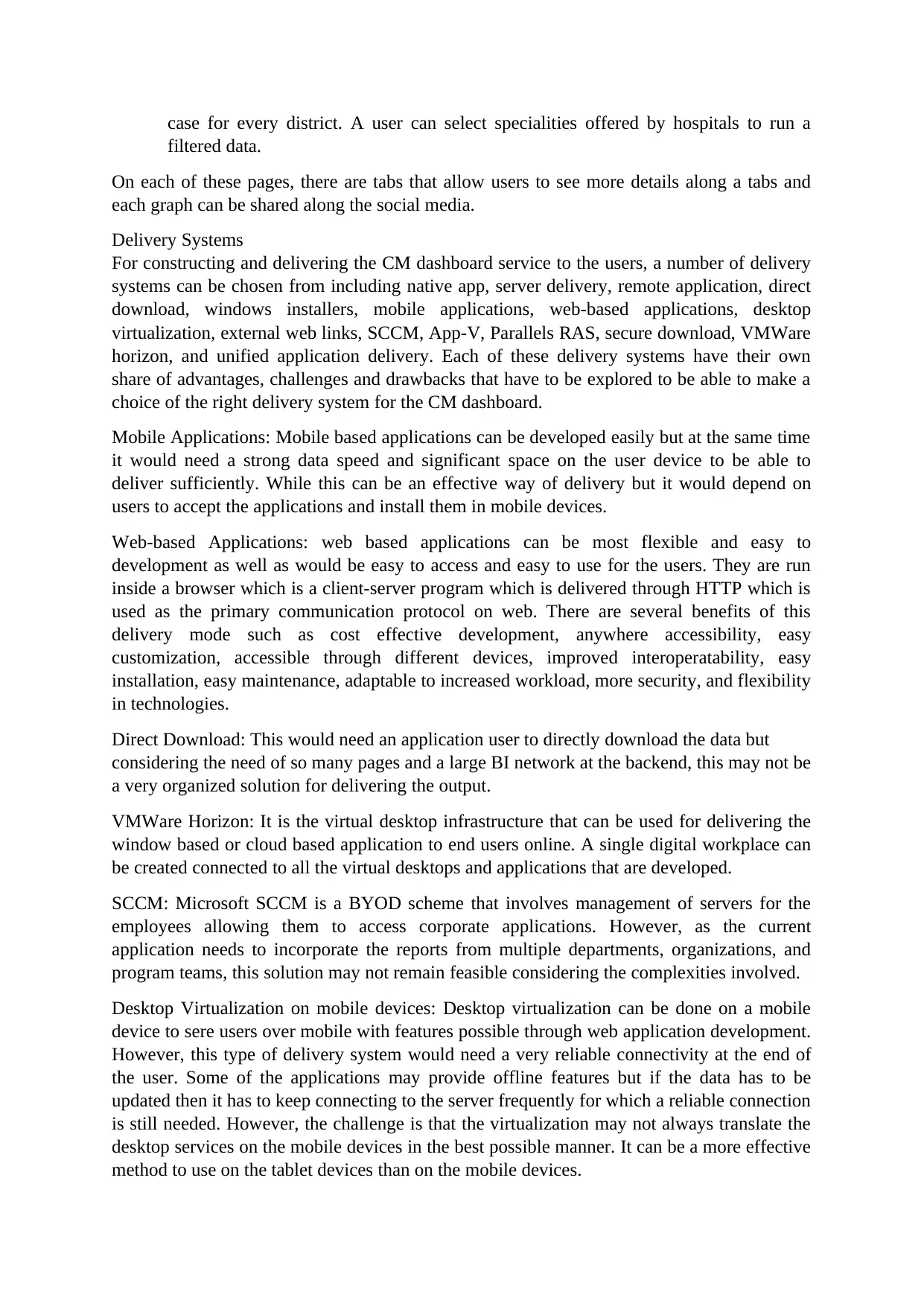
case for every district. A user can select specialities offered by hospitals to run a
filtered data.
On each of these pages, there are tabs that allow users to see more details along a tabs and
each graph can be shared along the social media.
Delivery Systems
For constructing and delivering the CM dashboard service to the users, a number of delivery
systems can be chosen from including native app, server delivery, remote application, direct
download, windows installers, mobile applications, web-based applications, desktop
virtualization, external web links, SCCM, App-V, Parallels RAS, secure download, VMWare
horizon, and unified application delivery. Each of these delivery systems have their own
share of advantages, challenges and drawbacks that have to be explored to be able to make a
choice of the right delivery system for the CM dashboard.
Mobile Applications: Mobile based applications can be developed easily but at the same time
it would need a strong data speed and significant space on the user device to be able to
deliver sufficiently. While this can be an effective way of delivery but it would depend on
users to accept the applications and install them in mobile devices.
Web-based Applications: web based applications can be most flexible and easy to
development as well as would be easy to access and easy to use for the users. They are run
inside a browser which is a client-server program which is delivered through HTTP which is
used as the primary communication protocol on web. There are several benefits of this
delivery mode such as cost effective development, anywhere accessibility, easy
customization, accessible through different devices, improved interoperatability, easy
installation, easy maintenance, adaptable to increased workload, more security, and flexibility
in technologies.
Direct Download: This would need an application user to directly download the data but
considering the need of so many pages and a large BI network at the backend, this may not be
a very organized solution for delivering the output.
VMWare Horizon: It is the virtual desktop infrastructure that can be used for delivering the
window based or cloud based application to end users online. A single digital workplace can
be created connected to all the virtual desktops and applications that are developed.
SCCM: Microsoft SCCM is a BYOD scheme that involves management of servers for the
employees allowing them to access corporate applications. However, as the current
application needs to incorporate the reports from multiple departments, organizations, and
program teams, this solution may not remain feasible considering the complexities involved.
Desktop Virtualization on mobile devices: Desktop virtualization can be done on a mobile
device to sere users over mobile with features possible through web application development.
However, this type of delivery system would need a very reliable connectivity at the end of
the user. Some of the applications may provide offline features but if the data has to be
updated then it has to keep connecting to the server frequently for which a reliable connection
is still needed. However, the challenge is that the virtualization may not always translate the
desktop services on the mobile devices in the best possible manner. It can be a more effective
method to use on the tablet devices than on the mobile devices.
filtered data.
On each of these pages, there are tabs that allow users to see more details along a tabs and
each graph can be shared along the social media.
Delivery Systems
For constructing and delivering the CM dashboard service to the users, a number of delivery
systems can be chosen from including native app, server delivery, remote application, direct
download, windows installers, mobile applications, web-based applications, desktop
virtualization, external web links, SCCM, App-V, Parallels RAS, secure download, VMWare
horizon, and unified application delivery. Each of these delivery systems have their own
share of advantages, challenges and drawbacks that have to be explored to be able to make a
choice of the right delivery system for the CM dashboard.
Mobile Applications: Mobile based applications can be developed easily but at the same time
it would need a strong data speed and significant space on the user device to be able to
deliver sufficiently. While this can be an effective way of delivery but it would depend on
users to accept the applications and install them in mobile devices.
Web-based Applications: web based applications can be most flexible and easy to
development as well as would be easy to access and easy to use for the users. They are run
inside a browser which is a client-server program which is delivered through HTTP which is
used as the primary communication protocol on web. There are several benefits of this
delivery mode such as cost effective development, anywhere accessibility, easy
customization, accessible through different devices, improved interoperatability, easy
installation, easy maintenance, adaptable to increased workload, more security, and flexibility
in technologies.
Direct Download: This would need an application user to directly download the data but
considering the need of so many pages and a large BI network at the backend, this may not be
a very organized solution for delivering the output.
VMWare Horizon: It is the virtual desktop infrastructure that can be used for delivering the
window based or cloud based application to end users online. A single digital workplace can
be created connected to all the virtual desktops and applications that are developed.
SCCM: Microsoft SCCM is a BYOD scheme that involves management of servers for the
employees allowing them to access corporate applications. However, as the current
application needs to incorporate the reports from multiple departments, organizations, and
program teams, this solution may not remain feasible considering the complexities involved.
Desktop Virtualization on mobile devices: Desktop virtualization can be done on a mobile
device to sere users over mobile with features possible through web application development.
However, this type of delivery system would need a very reliable connectivity at the end of
the user. Some of the applications may provide offline features but if the data has to be
updated then it has to keep connecting to the server frequently for which a reliable connection
is still needed. However, the challenge is that the virtualization may not always translate the
desktop services on the mobile devices in the best possible manner. It can be a more effective
method to use on the tablet devices than on the mobile devices.
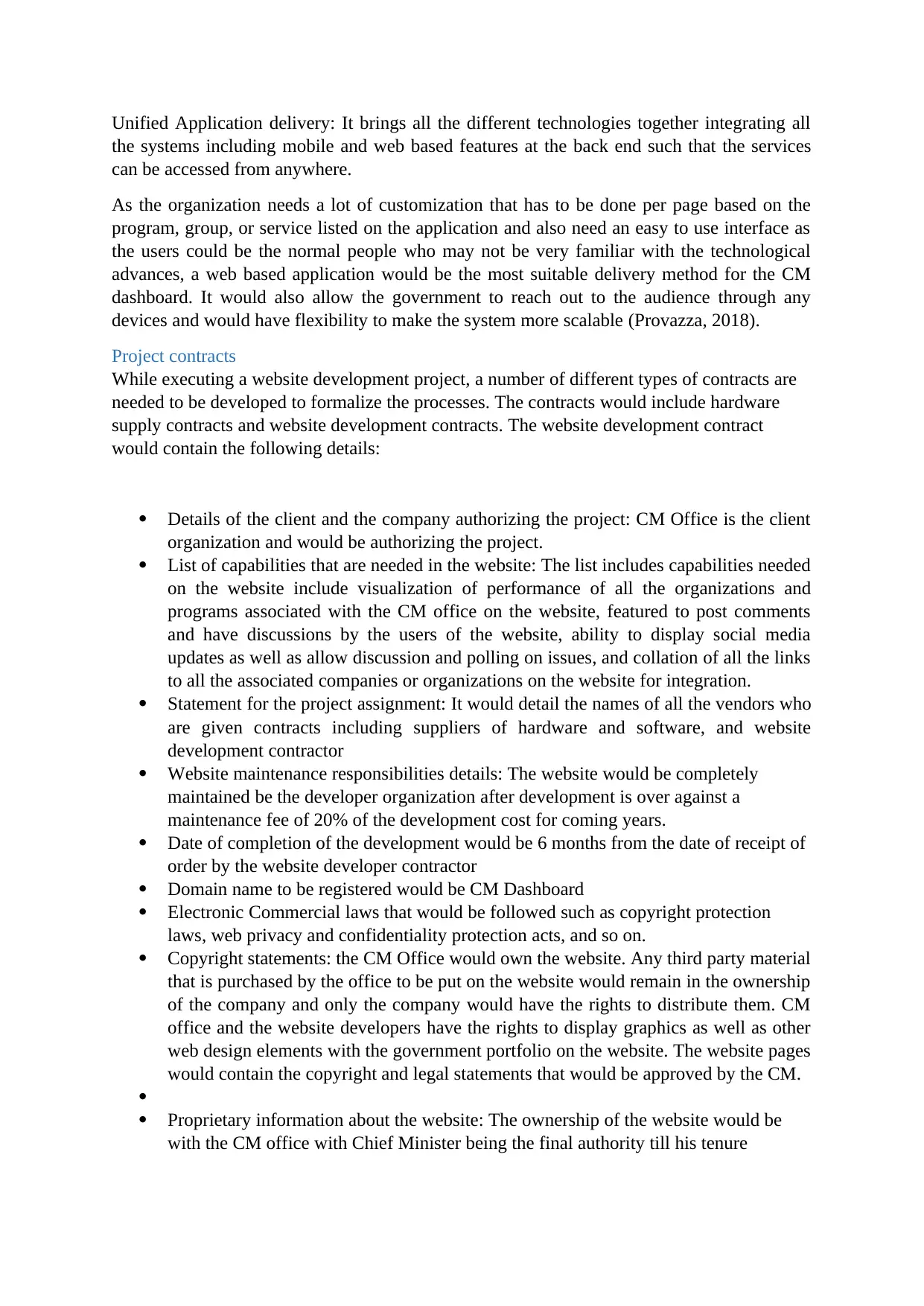
Unified Application delivery: It brings all the different technologies together integrating all
the systems including mobile and web based features at the back end such that the services
can be accessed from anywhere.
As the organization needs a lot of customization that has to be done per page based on the
program, group, or service listed on the application and also need an easy to use interface as
the users could be the normal people who may not be very familiar with the technological
advances, a web based application would be the most suitable delivery method for the CM
dashboard. It would also allow the government to reach out to the audience through any
devices and would have flexibility to make the system more scalable (Provazza, 2018).
Project contracts
While executing a website development project, a number of different types of contracts are
needed to be developed to formalize the processes. The contracts would include hardware
supply contracts and website development contracts. The website development contract
would contain the following details:
Details of the client and the company authorizing the project: CM Office is the client
organization and would be authorizing the project.
List of capabilities that are needed in the website: The list includes capabilities needed
on the website include visualization of performance of all the organizations and
programs associated with the CM office on the website, featured to post comments
and have discussions by the users of the website, ability to display social media
updates as well as allow discussion and polling on issues, and collation of all the links
to all the associated companies or organizations on the website for integration.
Statement for the project assignment: It would detail the names of all the vendors who
are given contracts including suppliers of hardware and software, and website
development contractor
Website maintenance responsibilities details: The website would be completely
maintained be the developer organization after development is over against a
maintenance fee of 20% of the development cost for coming years.
Date of completion of the development would be 6 months from the date of receipt of
order by the website developer contractor
Domain name to be registered would be CM Dashboard
Electronic Commercial laws that would be followed such as copyright protection
laws, web privacy and confidentiality protection acts, and so on.
Copyright statements: the CM Office would own the website. Any third party material
that is purchased by the office to be put on the website would remain in the ownership
of the company and only the company would have the rights to distribute them. CM
office and the website developers have the rights to display graphics as well as other
web design elements with the government portfolio on the website. The website pages
would contain the copyright and legal statements that would be approved by the CM.
Proprietary information about the website: The ownership of the website would be
with the CM office with Chief Minister being the final authority till his tenure
the systems including mobile and web based features at the back end such that the services
can be accessed from anywhere.
As the organization needs a lot of customization that has to be done per page based on the
program, group, or service listed on the application and also need an easy to use interface as
the users could be the normal people who may not be very familiar with the technological
advances, a web based application would be the most suitable delivery method for the CM
dashboard. It would also allow the government to reach out to the audience through any
devices and would have flexibility to make the system more scalable (Provazza, 2018).
Project contracts
While executing a website development project, a number of different types of contracts are
needed to be developed to formalize the processes. The contracts would include hardware
supply contracts and website development contracts. The website development contract
would contain the following details:
Details of the client and the company authorizing the project: CM Office is the client
organization and would be authorizing the project.
List of capabilities that are needed in the website: The list includes capabilities needed
on the website include visualization of performance of all the organizations and
programs associated with the CM office on the website, featured to post comments
and have discussions by the users of the website, ability to display social media
updates as well as allow discussion and polling on issues, and collation of all the links
to all the associated companies or organizations on the website for integration.
Statement for the project assignment: It would detail the names of all the vendors who
are given contracts including suppliers of hardware and software, and website
development contractor
Website maintenance responsibilities details: The website would be completely
maintained be the developer organization after development is over against a
maintenance fee of 20% of the development cost for coming years.
Date of completion of the development would be 6 months from the date of receipt of
order by the website developer contractor
Domain name to be registered would be CM Dashboard
Electronic Commercial laws that would be followed such as copyright protection
laws, web privacy and confidentiality protection acts, and so on.
Copyright statements: the CM Office would own the website. Any third party material
that is purchased by the office to be put on the website would remain in the ownership
of the company and only the company would have the rights to distribute them. CM
office and the website developers have the rights to display graphics as well as other
web design elements with the government portfolio on the website. The website pages
would contain the copyright and legal statements that would be approved by the CM.
Proprietary information about the website: The ownership of the website would be
with the CM office with Chief Minister being the final authority till his tenure
⊘ This is a preview!⊘
Do you want full access?
Subscribe today to unlock all pages.

Trusted by 1+ million students worldwide
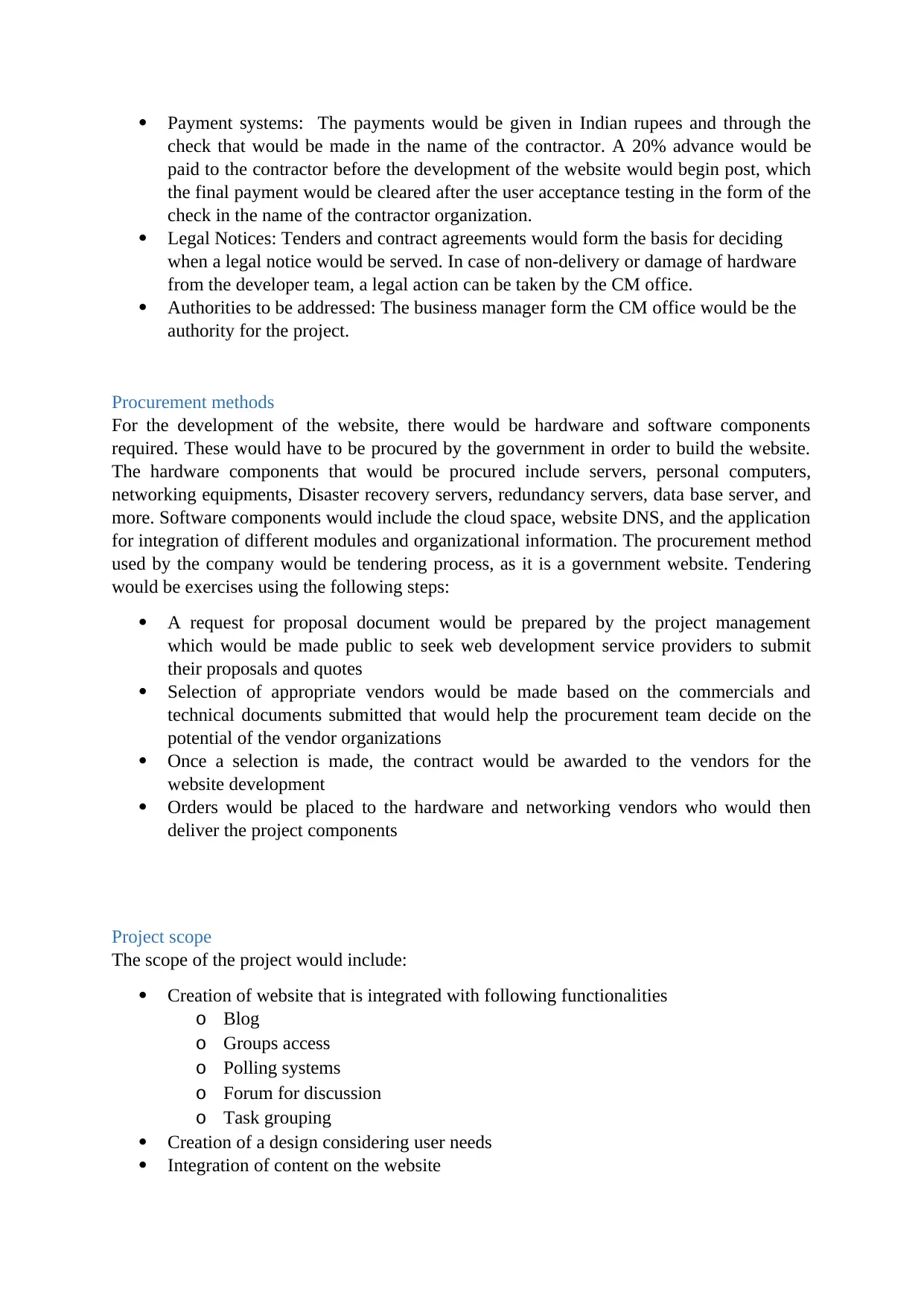
Payment systems: The payments would be given in Indian rupees and through the
check that would be made in the name of the contractor. A 20% advance would be
paid to the contractor before the development of the website would begin post, which
the final payment would be cleared after the user acceptance testing in the form of the
check in the name of the contractor organization.
Legal Notices: Tenders and contract agreements would form the basis for deciding
when a legal notice would be served. In case of non-delivery or damage of hardware
from the developer team, a legal action can be taken by the CM office.
Authorities to be addressed: The business manager form the CM office would be the
authority for the project.
Procurement methods
For the development of the website, there would be hardware and software components
required. These would have to be procured by the government in order to build the website.
The hardware components that would be procured include servers, personal computers,
networking equipments, Disaster recovery servers, redundancy servers, data base server, and
more. Software components would include the cloud space, website DNS, and the application
for integration of different modules and organizational information. The procurement method
used by the company would be tendering process, as it is a government website. Tendering
would be exercises using the following steps:
A request for proposal document would be prepared by the project management
which would be made public to seek web development service providers to submit
their proposals and quotes
Selection of appropriate vendors would be made based on the commercials and
technical documents submitted that would help the procurement team decide on the
potential of the vendor organizations
Once a selection is made, the contract would be awarded to the vendors for the
website development
Orders would be placed to the hardware and networking vendors who would then
deliver the project components
Project scope
The scope of the project would include:
Creation of website that is integrated with following functionalities
o Blog
o Groups access
o Polling systems
o Forum for discussion
o Task grouping
Creation of a design considering user needs
Integration of content on the website
check that would be made in the name of the contractor. A 20% advance would be
paid to the contractor before the development of the website would begin post, which
the final payment would be cleared after the user acceptance testing in the form of the
check in the name of the contractor organization.
Legal Notices: Tenders and contract agreements would form the basis for deciding
when a legal notice would be served. In case of non-delivery or damage of hardware
from the developer team, a legal action can be taken by the CM office.
Authorities to be addressed: The business manager form the CM office would be the
authority for the project.
Procurement methods
For the development of the website, there would be hardware and software components
required. These would have to be procured by the government in order to build the website.
The hardware components that would be procured include servers, personal computers,
networking equipments, Disaster recovery servers, redundancy servers, data base server, and
more. Software components would include the cloud space, website DNS, and the application
for integration of different modules and organizational information. The procurement method
used by the company would be tendering process, as it is a government website. Tendering
would be exercises using the following steps:
A request for proposal document would be prepared by the project management
which would be made public to seek web development service providers to submit
their proposals and quotes
Selection of appropriate vendors would be made based on the commercials and
technical documents submitted that would help the procurement team decide on the
potential of the vendor organizations
Once a selection is made, the contract would be awarded to the vendors for the
website development
Orders would be placed to the hardware and networking vendors who would then
deliver the project components
Project scope
The scope of the project would include:
Creation of website that is integrated with following functionalities
o Blog
o Groups access
o Polling systems
o Forum for discussion
o Task grouping
Creation of a design considering user needs
Integration of content on the website
Paraphrase This Document
Need a fresh take? Get an instant paraphrase of this document with our AI Paraphraser
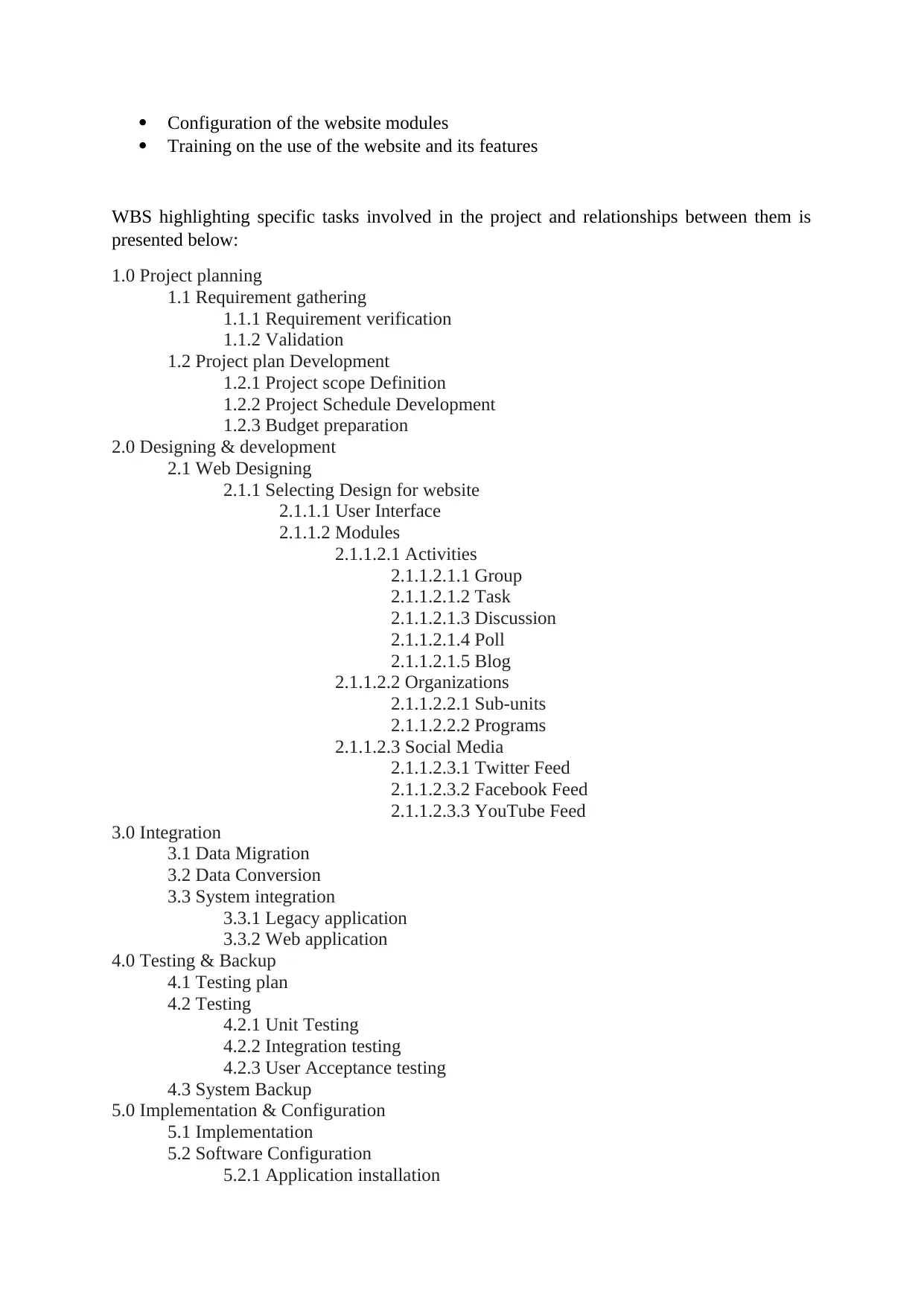
Configuration of the website modules
Training on the use of the website and its features
WBS highlighting specific tasks involved in the project and relationships between them is
presented below:
1.0 Project planning
1.1 Requirement gathering
1.1.1 Requirement verification
1.1.2 Validation
1.2 Project plan Development
1.2.1 Project scope Definition
1.2.2 Project Schedule Development
1.2.3 Budget preparation
2.0 Designing & development
2.1 Web Designing
2.1.1 Selecting Design for website
2.1.1.1 User Interface
2.1.1.2 Modules
2.1.1.2.1 Activities
2.1.1.2.1.1 Group
2.1.1.2.1.2 Task
2.1.1.2.1.3 Discussion
2.1.1.2.1.4 Poll
2.1.1.2.1.5 Blog
2.1.1.2.2 Organizations
2.1.1.2.2.1 Sub-units
2.1.1.2.2.2 Programs
2.1.1.2.3 Social Media
2.1.1.2.3.1 Twitter Feed
2.1.1.2.3.2 Facebook Feed
2.1.1.2.3.3 YouTube Feed
3.0 Integration
3.1 Data Migration
3.2 Data Conversion
3.3 System integration
3.3.1 Legacy application
3.3.2 Web application
4.0 Testing & Backup
4.1 Testing plan
4.2 Testing
4.2.1 Unit Testing
4.2.2 Integration testing
4.2.3 User Acceptance testing
4.3 System Backup
5.0 Implementation & Configuration
5.1 Implementation
5.2 Software Configuration
5.2.1 Application installation
Training on the use of the website and its features
WBS highlighting specific tasks involved in the project and relationships between them is
presented below:
1.0 Project planning
1.1 Requirement gathering
1.1.1 Requirement verification
1.1.2 Validation
1.2 Project plan Development
1.2.1 Project scope Definition
1.2.2 Project Schedule Development
1.2.3 Budget preparation
2.0 Designing & development
2.1 Web Designing
2.1.1 Selecting Design for website
2.1.1.1 User Interface
2.1.1.2 Modules
2.1.1.2.1 Activities
2.1.1.2.1.1 Group
2.1.1.2.1.2 Task
2.1.1.2.1.3 Discussion
2.1.1.2.1.4 Poll
2.1.1.2.1.5 Blog
2.1.1.2.2 Organizations
2.1.1.2.2.1 Sub-units
2.1.1.2.2.2 Programs
2.1.1.2.3 Social Media
2.1.1.2.3.1 Twitter Feed
2.1.1.2.3.2 Facebook Feed
2.1.1.2.3.3 YouTube Feed
3.0 Integration
3.1 Data Migration
3.2 Data Conversion
3.3 System integration
3.3.1 Legacy application
3.3.2 Web application
4.0 Testing & Backup
4.1 Testing plan
4.2 Testing
4.2.1 Unit Testing
4.2.2 Integration testing
4.2.3 User Acceptance testing
4.3 System Backup
5.0 Implementation & Configuration
5.1 Implementation
5.2 Software Configuration
5.2.1 Application installation
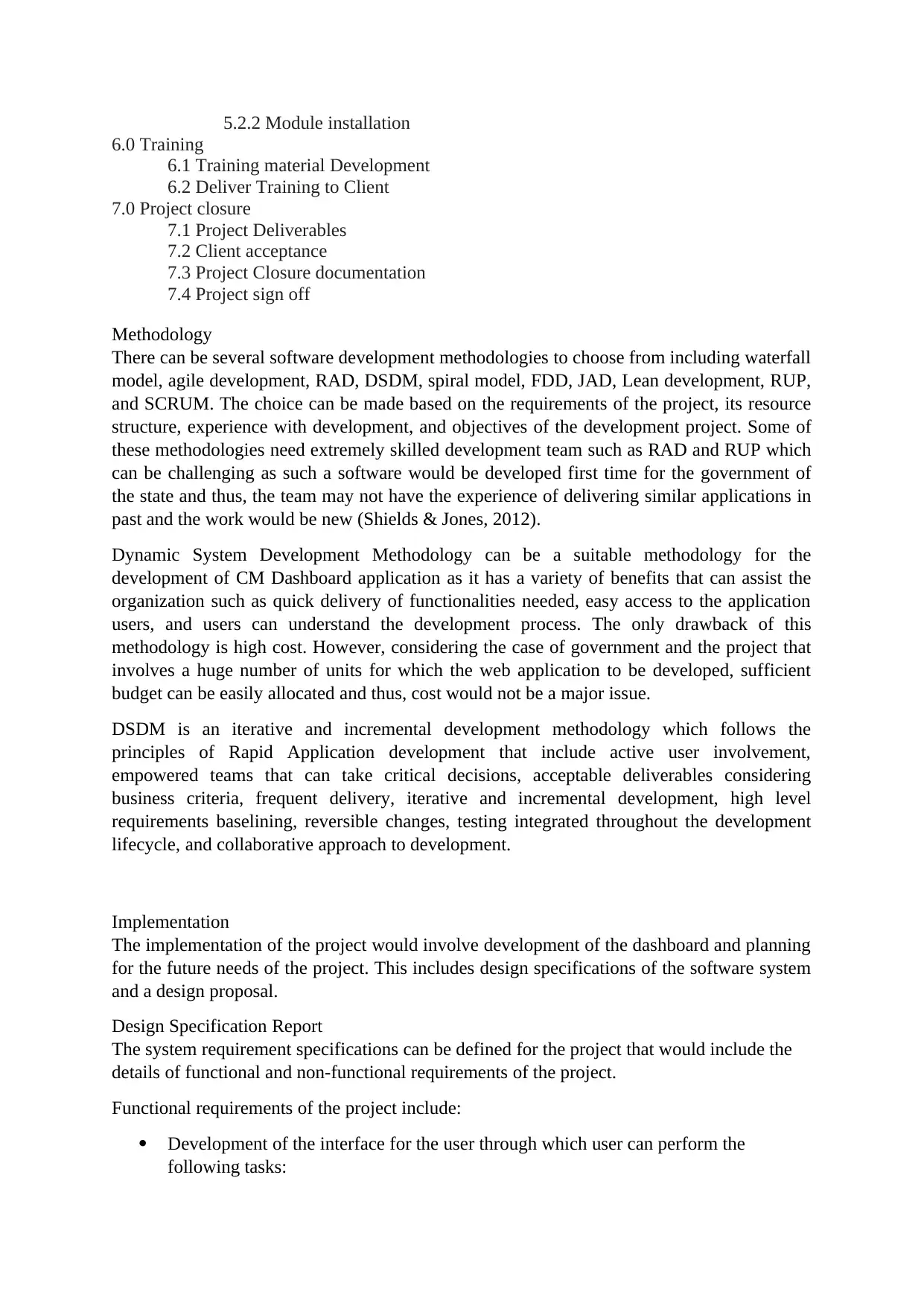
5.2.2 Module installation
6.0 Training
6.1 Training material Development
6.2 Deliver Training to Client
7.0 Project closure
7.1 Project Deliverables
7.2 Client acceptance
7.3 Project Closure documentation
7.4 Project sign off
Methodology
There can be several software development methodologies to choose from including waterfall
model, agile development, RAD, DSDM, spiral model, FDD, JAD, Lean development, RUP,
and SCRUM. The choice can be made based on the requirements of the project, its resource
structure, experience with development, and objectives of the development project. Some of
these methodologies need extremely skilled development team such as RAD and RUP which
can be challenging as such a software would be developed first time for the government of
the state and thus, the team may not have the experience of delivering similar applications in
past and the work would be new (Shields & Jones, 2012).
Dynamic System Development Methodology can be a suitable methodology for the
development of CM Dashboard application as it has a variety of benefits that can assist the
organization such as quick delivery of functionalities needed, easy access to the application
users, and users can understand the development process. The only drawback of this
methodology is high cost. However, considering the case of government and the project that
involves a huge number of units for which the web application to be developed, sufficient
budget can be easily allocated and thus, cost would not be a major issue.
DSDM is an iterative and incremental development methodology which follows the
principles of Rapid Application development that include active user involvement,
empowered teams that can take critical decisions, acceptable deliverables considering
business criteria, frequent delivery, iterative and incremental development, high level
requirements baselining, reversible changes, testing integrated throughout the development
lifecycle, and collaborative approach to development.
Implementation
The implementation of the project would involve development of the dashboard and planning
for the future needs of the project. This includes design specifications of the software system
and a design proposal.
Design Specification Report
The system requirement specifications can be defined for the project that would include the
details of functional and non-functional requirements of the project.
Functional requirements of the project include:
Development of the interface for the user through which user can perform the
following tasks:
6.0 Training
6.1 Training material Development
6.2 Deliver Training to Client
7.0 Project closure
7.1 Project Deliverables
7.2 Client acceptance
7.3 Project Closure documentation
7.4 Project sign off
Methodology
There can be several software development methodologies to choose from including waterfall
model, agile development, RAD, DSDM, spiral model, FDD, JAD, Lean development, RUP,
and SCRUM. The choice can be made based on the requirements of the project, its resource
structure, experience with development, and objectives of the development project. Some of
these methodologies need extremely skilled development team such as RAD and RUP which
can be challenging as such a software would be developed first time for the government of
the state and thus, the team may not have the experience of delivering similar applications in
past and the work would be new (Shields & Jones, 2012).
Dynamic System Development Methodology can be a suitable methodology for the
development of CM Dashboard application as it has a variety of benefits that can assist the
organization such as quick delivery of functionalities needed, easy access to the application
users, and users can understand the development process. The only drawback of this
methodology is high cost. However, considering the case of government and the project that
involves a huge number of units for which the web application to be developed, sufficient
budget can be easily allocated and thus, cost would not be a major issue.
DSDM is an iterative and incremental development methodology which follows the
principles of Rapid Application development that include active user involvement,
empowered teams that can take critical decisions, acceptable deliverables considering
business criteria, frequent delivery, iterative and incremental development, high level
requirements baselining, reversible changes, testing integrated throughout the development
lifecycle, and collaborative approach to development.
Implementation
The implementation of the project would involve development of the dashboard and planning
for the future needs of the project. This includes design specifications of the software system
and a design proposal.
Design Specification Report
The system requirement specifications can be defined for the project that would include the
details of functional and non-functional requirements of the project.
Functional requirements of the project include:
Development of the interface for the user through which user can perform the
following tasks:
⊘ This is a preview!⊘
Do you want full access?
Subscribe today to unlock all pages.

Trusted by 1+ million students worldwide
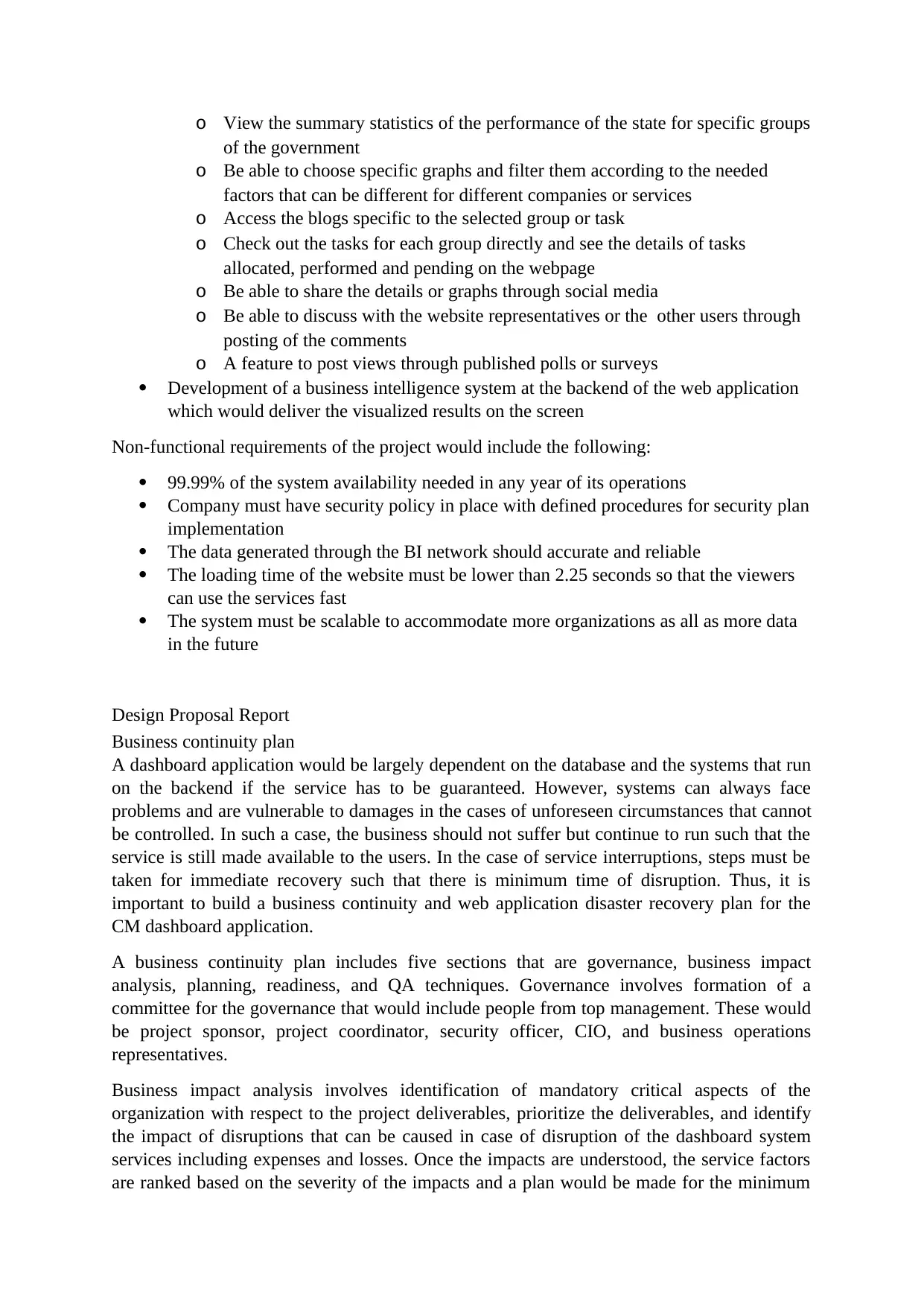
o View the summary statistics of the performance of the state for specific groups
of the government
o Be able to choose specific graphs and filter them according to the needed
factors that can be different for different companies or services
o Access the blogs specific to the selected group or task
o Check out the tasks for each group directly and see the details of tasks
allocated, performed and pending on the webpage
o Be able to share the details or graphs through social media
o Be able to discuss with the website representatives or the other users through
posting of the comments
o A feature to post views through published polls or surveys
Development of a business intelligence system at the backend of the web application
which would deliver the visualized results on the screen
Non-functional requirements of the project would include the following:
99.99% of the system availability needed in any year of its operations
Company must have security policy in place with defined procedures for security plan
implementation
The data generated through the BI network should accurate and reliable
The loading time of the website must be lower than 2.25 seconds so that the viewers
can use the services fast
The system must be scalable to accommodate more organizations as all as more data
in the future
Design Proposal Report
Business continuity plan
A dashboard application would be largely dependent on the database and the systems that run
on the backend if the service has to be guaranteed. However, systems can always face
problems and are vulnerable to damages in the cases of unforeseen circumstances that cannot
be controlled. In such a case, the business should not suffer but continue to run such that the
service is still made available to the users. In the case of service interruptions, steps must be
taken for immediate recovery such that there is minimum time of disruption. Thus, it is
important to build a business continuity and web application disaster recovery plan for the
CM dashboard application.
A business continuity plan includes five sections that are governance, business impact
analysis, planning, readiness, and QA techniques. Governance involves formation of a
committee for the governance that would include people from top management. These would
be project sponsor, project coordinator, security officer, CIO, and business operations
representatives.
Business impact analysis involves identification of mandatory critical aspects of the
organization with respect to the project deliverables, prioritize the deliverables, and identify
the impact of disruptions that can be caused in case of disruption of the dashboard system
services including expenses and losses. Once the impacts are understood, the service factors
are ranked based on the severity of the impacts and a plan would be made for the minimum
of the government
o Be able to choose specific graphs and filter them according to the needed
factors that can be different for different companies or services
o Access the blogs specific to the selected group or task
o Check out the tasks for each group directly and see the details of tasks
allocated, performed and pending on the webpage
o Be able to share the details or graphs through social media
o Be able to discuss with the website representatives or the other users through
posting of the comments
o A feature to post views through published polls or surveys
Development of a business intelligence system at the backend of the web application
which would deliver the visualized results on the screen
Non-functional requirements of the project would include the following:
99.99% of the system availability needed in any year of its operations
Company must have security policy in place with defined procedures for security plan
implementation
The data generated through the BI network should accurate and reliable
The loading time of the website must be lower than 2.25 seconds so that the viewers
can use the services fast
The system must be scalable to accommodate more organizations as all as more data
in the future
Design Proposal Report
Business continuity plan
A dashboard application would be largely dependent on the database and the systems that run
on the backend if the service has to be guaranteed. However, systems can always face
problems and are vulnerable to damages in the cases of unforeseen circumstances that cannot
be controlled. In such a case, the business should not suffer but continue to run such that the
service is still made available to the users. In the case of service interruptions, steps must be
taken for immediate recovery such that there is minimum time of disruption. Thus, it is
important to build a business continuity and web application disaster recovery plan for the
CM dashboard application.
A business continuity plan includes five sections that are governance, business impact
analysis, planning, readiness, and QA techniques. Governance involves formation of a
committee for the governance that would include people from top management. These would
be project sponsor, project coordinator, security officer, CIO, and business operations
representatives.
Business impact analysis involves identification of mandatory critical aspects of the
organization with respect to the project deliverables, prioritize the deliverables, and identify
the impact of disruptions that can be caused in case of disruption of the dashboard system
services including expenses and losses. Once the impacts are understood, the service factors
are ranked based on the severity of the impacts and a plan would be made for the minimum
Paraphrase This Document
Need a fresh take? Get an instant paraphrase of this document with our AI Paraphraser
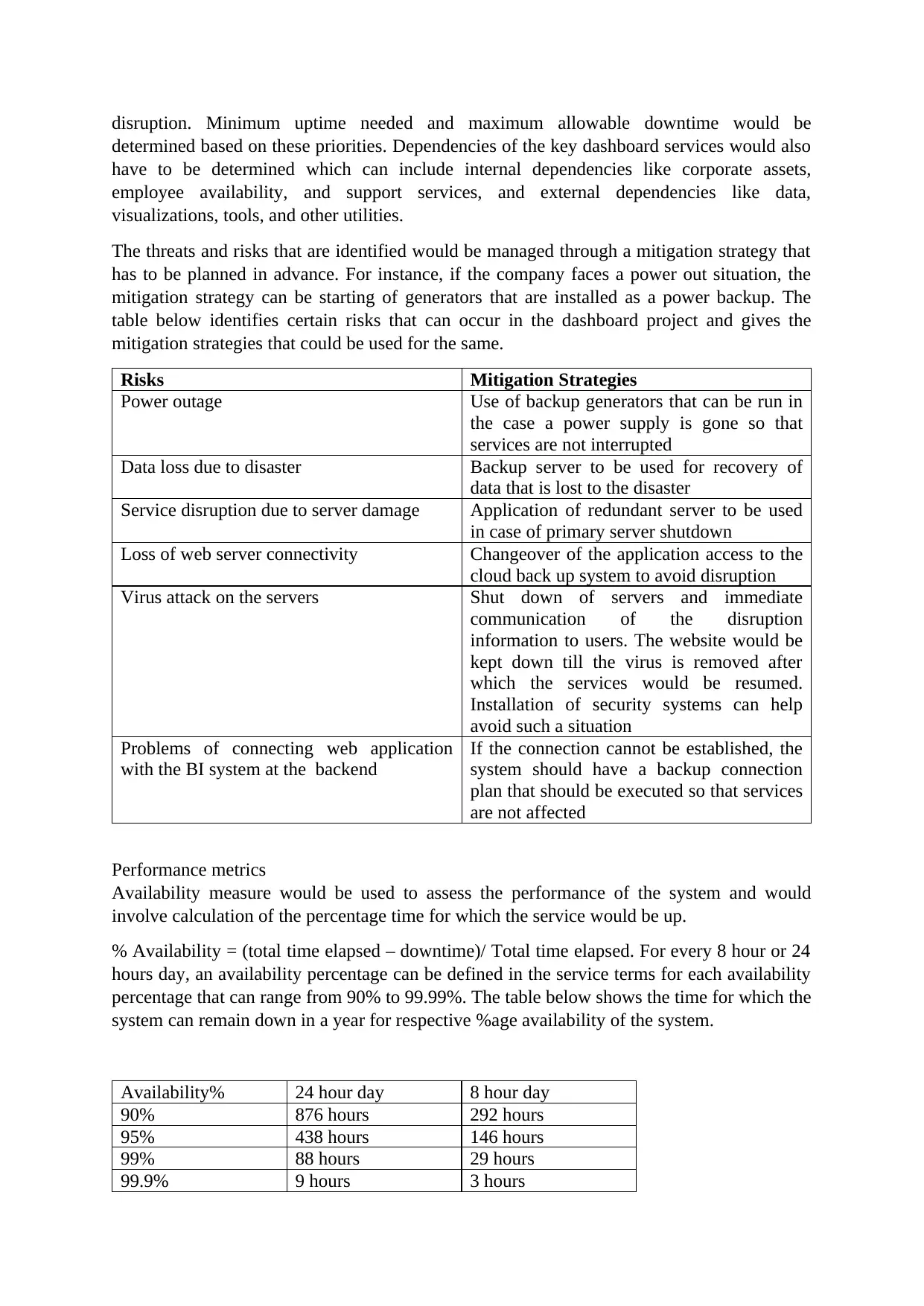
disruption. Minimum uptime needed and maximum allowable downtime would be
determined based on these priorities. Dependencies of the key dashboard services would also
have to be determined which can include internal dependencies like corporate assets,
employee availability, and support services, and external dependencies like data,
visualizations, tools, and other utilities.
The threats and risks that are identified would be managed through a mitigation strategy that
has to be planned in advance. For instance, if the company faces a power out situation, the
mitigation strategy can be starting of generators that are installed as a power backup. The
table below identifies certain risks that can occur in the dashboard project and gives the
mitigation strategies that could be used for the same.
Risks Mitigation Strategies
Power outage Use of backup generators that can be run in
the case a power supply is gone so that
services are not interrupted
Data loss due to disaster Backup server to be used for recovery of
data that is lost to the disaster
Service disruption due to server damage Application of redundant server to be used
in case of primary server shutdown
Loss of web server connectivity Changeover of the application access to the
cloud back up system to avoid disruption
Virus attack on the servers Shut down of servers and immediate
communication of the disruption
information to users. The website would be
kept down till the virus is removed after
which the services would be resumed.
Installation of security systems can help
avoid such a situation
Problems of connecting web application
with the BI system at the backend
If the connection cannot be established, the
system should have a backup connection
plan that should be executed so that services
are not affected
Performance metrics
Availability measure would be used to assess the performance of the system and would
involve calculation of the percentage time for which the service would be up.
% Availability = (total time elapsed – downtime)/ Total time elapsed. For every 8 hour or 24
hours day, an availability percentage can be defined in the service terms for each availability
percentage that can range from 90% to 99.99%. The table below shows the time for which the
system can remain down in a year for respective %age availability of the system.
Availability% 24 hour day 8 hour day
90% 876 hours 292 hours
95% 438 hours 146 hours
99% 88 hours 29 hours
99.9% 9 hours 3 hours
determined based on these priorities. Dependencies of the key dashboard services would also
have to be determined which can include internal dependencies like corporate assets,
employee availability, and support services, and external dependencies like data,
visualizations, tools, and other utilities.
The threats and risks that are identified would be managed through a mitigation strategy that
has to be planned in advance. For instance, if the company faces a power out situation, the
mitigation strategy can be starting of generators that are installed as a power backup. The
table below identifies certain risks that can occur in the dashboard project and gives the
mitigation strategies that could be used for the same.
Risks Mitigation Strategies
Power outage Use of backup generators that can be run in
the case a power supply is gone so that
services are not interrupted
Data loss due to disaster Backup server to be used for recovery of
data that is lost to the disaster
Service disruption due to server damage Application of redundant server to be used
in case of primary server shutdown
Loss of web server connectivity Changeover of the application access to the
cloud back up system to avoid disruption
Virus attack on the servers Shut down of servers and immediate
communication of the disruption
information to users. The website would be
kept down till the virus is removed after
which the services would be resumed.
Installation of security systems can help
avoid such a situation
Problems of connecting web application
with the BI system at the backend
If the connection cannot be established, the
system should have a backup connection
plan that should be executed so that services
are not affected
Performance metrics
Availability measure would be used to assess the performance of the system and would
involve calculation of the percentage time for which the service would be up.
% Availability = (total time elapsed – downtime)/ Total time elapsed. For every 8 hour or 24
hours day, an availability percentage can be defined in the service terms for each availability
percentage that can range from 90% to 99.99%. The table below shows the time for which the
system can remain down in a year for respective %age availability of the system.
Availability% 24 hour day 8 hour day
90% 876 hours 292 hours
95% 438 hours 146 hours
99% 88 hours 29 hours
99.9% 9 hours 3 hours
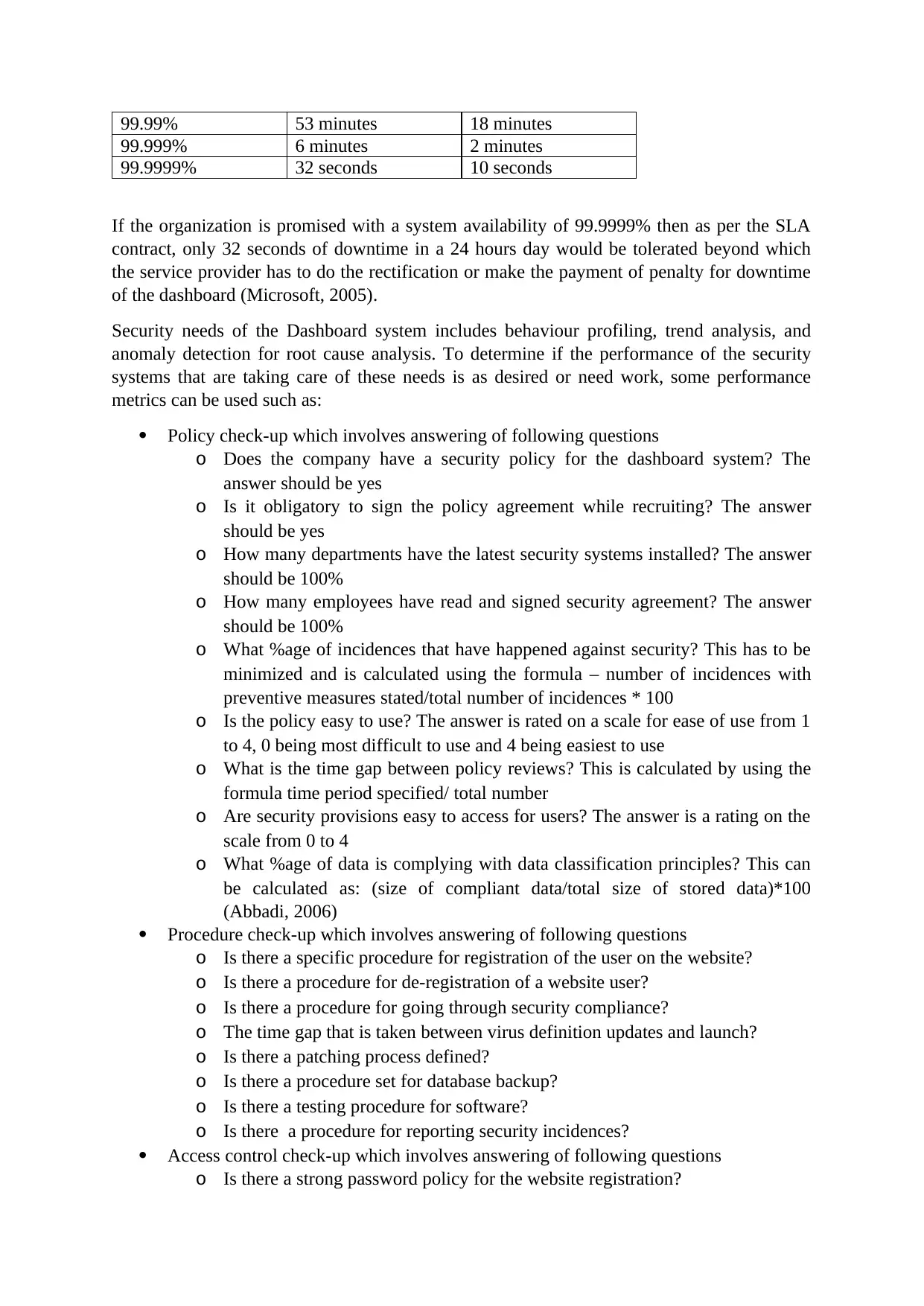
99.99% 53 minutes 18 minutes
99.999% 6 minutes 2 minutes
99.9999% 32 seconds 10 seconds
If the organization is promised with a system availability of 99.9999% then as per the SLA
contract, only 32 seconds of downtime in a 24 hours day would be tolerated beyond which
the service provider has to do the rectification or make the payment of penalty for downtime
of the dashboard (Microsoft, 2005).
Security needs of the Dashboard system includes behaviour profiling, trend analysis, and
anomaly detection for root cause analysis. To determine if the performance of the security
systems that are taking care of these needs is as desired or need work, some performance
metrics can be used such as:
Policy check-up which involves answering of following questions
o Does the company have a security policy for the dashboard system? The
answer should be yes
o Is it obligatory to sign the policy agreement while recruiting? The answer
should be yes
o How many departments have the latest security systems installed? The answer
should be 100%
o How many employees have read and signed security agreement? The answer
should be 100%
o What %age of incidences that have happened against security? This has to be
minimized and is calculated using the formula – number of incidences with
preventive measures stated/total number of incidences * 100
o Is the policy easy to use? The answer is rated on a scale for ease of use from 1
to 4, 0 being most difficult to use and 4 being easiest to use
o What is the time gap between policy reviews? This is calculated by using the
formula time period specified/ total number
o Are security provisions easy to access for users? The answer is a rating on the
scale from 0 to 4
o What %age of data is complying with data classification principles? This can
be calculated as: (size of compliant data/total size of stored data)*100
(Abbadi, 2006)
Procedure check-up which involves answering of following questions
o Is there a specific procedure for registration of the user on the website?
o Is there a procedure for de-registration of a website user?
o Is there a procedure for going through security compliance?
o The time gap that is taken between virus definition updates and launch?
o Is there a patching process defined?
o Is there a procedure set for database backup?
o Is there a testing procedure for software?
o Is there a procedure for reporting security incidences?
Access control check-up which involves answering of following questions
o Is there a strong password policy for the website registration?
99.999% 6 minutes 2 minutes
99.9999% 32 seconds 10 seconds
If the organization is promised with a system availability of 99.9999% then as per the SLA
contract, only 32 seconds of downtime in a 24 hours day would be tolerated beyond which
the service provider has to do the rectification or make the payment of penalty for downtime
of the dashboard (Microsoft, 2005).
Security needs of the Dashboard system includes behaviour profiling, trend analysis, and
anomaly detection for root cause analysis. To determine if the performance of the security
systems that are taking care of these needs is as desired or need work, some performance
metrics can be used such as:
Policy check-up which involves answering of following questions
o Does the company have a security policy for the dashboard system? The
answer should be yes
o Is it obligatory to sign the policy agreement while recruiting? The answer
should be yes
o How many departments have the latest security systems installed? The answer
should be 100%
o How many employees have read and signed security agreement? The answer
should be 100%
o What %age of incidences that have happened against security? This has to be
minimized and is calculated using the formula – number of incidences with
preventive measures stated/total number of incidences * 100
o Is the policy easy to use? The answer is rated on a scale for ease of use from 1
to 4, 0 being most difficult to use and 4 being easiest to use
o What is the time gap between policy reviews? This is calculated by using the
formula time period specified/ total number
o Are security provisions easy to access for users? The answer is a rating on the
scale from 0 to 4
o What %age of data is complying with data classification principles? This can
be calculated as: (size of compliant data/total size of stored data)*100
(Abbadi, 2006)
Procedure check-up which involves answering of following questions
o Is there a specific procedure for registration of the user on the website?
o Is there a procedure for de-registration of a website user?
o Is there a procedure for going through security compliance?
o The time gap that is taken between virus definition updates and launch?
o Is there a patching process defined?
o Is there a procedure set for database backup?
o Is there a testing procedure for software?
o Is there a procedure for reporting security incidences?
Access control check-up which involves answering of following questions
o Is there a strong password policy for the website registration?
⊘ This is a preview!⊘
Do you want full access?
Subscribe today to unlock all pages.

Trusted by 1+ million students worldwide
1 out of 16
Related Documents
Your All-in-One AI-Powered Toolkit for Academic Success.
+13062052269
info@desklib.com
Available 24*7 on WhatsApp / Email
![[object Object]](/_next/static/media/star-bottom.7253800d.svg)
Unlock your academic potential
Copyright © 2020–2025 A2Z Services. All Rights Reserved. Developed and managed by ZUCOL.





